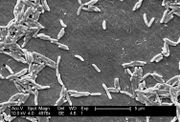Campylobacter
| Campylobacter | ||||||||||||
|---|---|---|---|---|---|---|---|---|---|---|---|---|
 SEM micrograph of C. fetus
| ||||||||||||
| Scientific classification | ||||||||||||
| ||||||||||||
| Species | ||||||||||||
|
C. coli |
The genus Campylobacter are Gram-negative, spiral, microaerophilic bacteria. Motile, with either uni- or bi-polar flagella, the organisms have a somewhat curved, rod-like appearance, and are oxidase-positive.[1] Campylobacter jejuni is now recognised as one of the main causes of bacterial foodborne disease in many developed countries.[2] At least a dozen species of Campylobacter have been implicated in human disease, with C. jejuni and C. coli the most common.[1] C. fetus is a cause of spontaneous abortions in cattle and sheep, as well as an opportunisitic pathogen in humans.[3]
Genome
The genomes of several Campylobacter species have been sequenced, providing insights into their mechanisms of pathogenesis.[4]
Campylobacter species contain two flagellin genes in tandem for motility, flaA and flaB. These genes undergo intergenic recombination, further contributing to their virulence. [5] Non-motile mutants do not colonize.
Pathogenesis
Campylobacteriosis is an infection by campylobacter [6]. The common routes of transmission are fecal-oral, person-to-person sexual contact, ingestion of contaminated food or water. It produces an inflammatory, sometimes bloody, diarrhea, periodontitis [7] or dysentery syndrome, mostly including cramps, fever and pain. The infection is usually self-limiting and in most cases, symptomatic treatment by reposition of liquid and electrolyte replacement is enough in human infections. The use of antibiotics, on the other hand, is controversial.
Cause
This is most commonly caused by C. jejuni, a spiral and comma shaped bacterium normally found in cattle, swine, and birds, where it is non-pathogenic. But the illness can also be caused by C. coli (also found in cattle, swine, and birds) C. upsaliensis (found in cats and dogs) and C. lari (present in seabirds in particular).
One cause of the effects of campylobacteriosis is tissue injury in the gut. The sites of tissue injury include the jejunum, the ileum, and the colon. C jejuni appears to achieve this by invading and destroying epithelial cells.
Some strains of C jejuni produce a cholera-like enterotoxin, which is important in the watery diarrhea observed in infections. The organism produces diffuse, bloody, edematous, and exudative enteritis. In a small number of cases, the infection may be associated with hemolytic uremic syndrome and thrombotic thrombocytopenic purpura through a poorly understood mechanism.
Gallery
-
3D computer-generated image of a cluster of drug-resistant Campylobacter bacteria. From Public Health Image Library (PHIL). [8]
References
- ↑ 1.0 1.1 Ryan KJ; Ray CG (editors) (2004). Sherris Medical Microbiology (4th ed. ed.). McGraw Hill. pp. pp. 378&ndash, 80. ISBN 0838585299.
- ↑ Moore JE; et al. (2005). "Campylobacter". Vet Res. 36 (3): 351–82. PMID 15845230.
- ↑ Sauerwein R, Bisseling J, Horrevorts A (1993). "Septic abortion associated with Campylobacter fetus subspecies fetus infection: case report and review of the literature". Infection. 21 (5): 331–3. PMID 8300253.
- ↑ Fouts DE; et al. (2005). "Major structural differences and novel potential virulence mechanisms from the genomes of multiple Campylobacter species". PLoS Biol. 3 (1): e15. doi:10.1371/journal.pbio.0030015. PMID 15660156.
- ↑ Grant C, Konkel M, Cieplak W, Tompkins L (1993). "Role of flagella in adherence, internalization, and translocation of Campylobacter jejuni in nonpolarized and polarized epithelial cell cultures". Infect Immun. 61 (5): 1764–71. PMID 8478066.
- ↑ cdc.gov
- ↑ Humphrey, Tom; et al. (2007). "Campylobacters as zoonotic pathogens: A food production perspective <internet>". International Journal of Food Microbiology. 117 (3). doi:10.1016 Check
|doi=value (help). - ↑ "Public Health Image Library (PHIL)".
See also
External links
ca:Campilobàcter de:Campylobacter hr:Campylobacter nl:Campylobacter no:Campylobacter uk:Campylobacter
![3D computer-generated image of a cluster of drug-resistant Campylobacter bacteria. From Public Health Image Library (PHIL). [8]](/images/c/cb/Campylobacter01.jpeg)